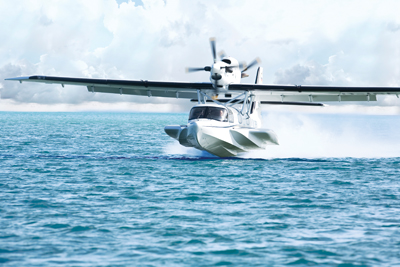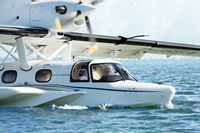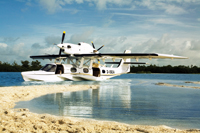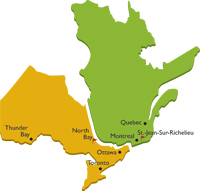
Features
Operations
THE DORNIER SEASTAR
The crowd of Montrealers had never seen anything like it.
April 14, 2010 By Peter Pigott
The crowd of Montrealers had never seen anything like it. On a July day in 1932, they watched a metal seaplane land smoothly on the St. Lawrence River and taxi up to the Longueuil shore. Called “Greenland Whale,” the Dornier had been in the air for an amazing 10 hours, flying all the way from Labrador – and before that Greenland, Iceland and Germany. Interviewed later on Montreal radio station CKAC, the pilot, Wolfgang von Gronau, told listeners he was demonstrating that by using seas, rivers and lakes, a seaplane could circumnavigate the globe. When asked about his aircraft’s unique design, von Gronau said the monohull with the parasol wing was typical of its builder, the German aviation pioneer Claude Dornier. Gronau would continue on to Winnipeg and then Prince Rupert, B.C., before making for Siberia and eventually back to Germany. His Dornier aircraft would be the first flying boat to complete an around the world flight.

|
Seventy-seven years later, at the NBAA Annual Meeting & Convention in Orlando, Fla., on Oct. 20, 2009, it was announced that a Dornier seaplane was once again taking up shop in Canada. Joe Walker, Dornier Seaplane’s chief executive officer announced the Punta Gorda, Fla.-based company had more than 25 letters of intent, allowing it to launch production of its Seastar amphibian. A final assembly site had been narrowed to two Canadian cities – St.-Jean-sur-Richelieu, Que., or North Bay, Ont. The cities had been selected because of the local labour pool, available real estate and infrastructure and also because the aircraft’s Pratt & Whitney Canada PT6-135A turboprop engines were built close by in Montreal. With so many lakes and rivers around each city, either would be a natural fit for the testing of the amphibious seaplane.
The Dornier Seaplane Company is owned by the family of Conrado Dornier whose grandfather had once worked with Count Zeppelin before he founded “Dornier Metallbauten” to build seaplanes. The Seastar had been designed by his son, Claudius Dornier Jr., chairman of the group of Dornier companies who sought to restart amphibious aviation by using an all-composite flying boat to overcome water corrosion and leakage. “The similarity of the Seastar to legacy Dornier aircraft is apparent in its basic design,” said Jim Holcombe, head of sales and marketing. “The high wing design with the fore-and-aft facing engines is a proven design feature of Dornier aircraft dating to the 1930s.” But if the influence of the old Dornier design is still evident – this is an entirely new aircraft.

|
| The Seastar’s all-composite airframe makes it immune to hull leakage and salt-water corrosion. Advertisement
PHOTO: DORNIER
|
Wolfgang von Gronau would have appreciated the Seastar’s all-composite airframe, making it immune to hull leakage and salt-water corrosion. This is what every seaplane builder, from Glenn Curtiss onward, has dreamed of. From the Sunderland flying boat to the PBY Catalina, salt-water corrosion has been the Achilles heel in the development of metal seaplanes. Aircraft that operate on water are extremely susceptible to corrosion. (Simply put, corrosion weakens metal structures and must be constantly controlled to keep the aircraft in a safe, airworthy condition.) To overcome this, other seaplane manufacturers have constructed their aircraft of aluminum – but that corrodes over time. Now using composite materials, Dornier has eliminated corrosion forever and with a virtually all-composite construction, the Seastar is effectively corrosion free.
Besides eliminating potential leaks, the composite airframe would warm the heart of the company accountant for its lower maintenance costs. The importance of this feature is illustrated by the information provided by the preeminent provider of aircraft cost and performance reports, Conklin & de Decker. It estimates that the total maintenance cost per flight hour of the twin-engine Seastar is US$90.15 versus US$95.94 for the single-engine Cessna Caravan, and US$151.25 for the twin-engine Twin Otter. This translates to a maintenance-per-seat mile cost of US$0.042 for the Seastar compared to US$0.071 for the Caravan and US$0.078 for the Twin Otter – a sizeable advantage for the Seastar. The Seastar will have a much higher residual value than aluminum aircraft at the end of the product life cycle – something not lost on its owners.
The integrated-hull flying boat design also reduces drag and provides the aircraft with a considerable advantage in maximum cruise speeds. For example, the Seastar has a maximum cruise speed of 180 KTAS, 30 to 50 knots faster than its competition. Reduced drag also provides greater fuel efficiency and increased range. Because the Seastar is a true seaplane, a flying boat by its design, it offers a critical operational benefit over the float plane – the ability to safely operate in seas of up to three feet.
The parasol wing on struts would also have been familiar to Von Gronau.
 |
| The high-wing design of the Seastar with fore-and-aft facing engines is a proven design feature of Dornier aircraft.
PHOTO: DORNIER
|
He would agree it does create drag – but by separating the wing entirely from the fuselage (he might have pointed out), it produces more lift – making the wing more efficient. “As with everything in aviation,” said Holcombe, “it is all about trade-offs. The increase in height of the wing allows us to position our engines more effectively giving us negligible water ingestion into them and the props. Prop erosion is a constant battle on seaplanes that we have successfully avoided, along with gaining the safety, operational, and training advantages of centerline thrust.”
In 1925, the great polar explorer Roald Amundsen chose Dornier flying boats to go to the North Pole because of their Duralumin flat-bottomed fuselages with projecting sponsons. He knew that the sponsons would stabilize the craft in icy seas much more than wing mounted stabilizer floats. But after the 1930s, because of their weight and rigidity, aircraft designers moved away from sponsons to lighter wing floats. For the Seastar, Dornier developed a streamlined two-stage sponson – the strong inboard section helps with moving the aircraft to the step while the higher-riding outboard section keeps it level in displacement – as wing floats would. And you don’t have to be a globe-girdling pilot to know the sponsons are perfect for fuel storage, increasing stability on and off the step by lowering the center of gravity (CG) considerably. Take off and maneuvering is actually aided rather than hindered by the sponsons as the pilot is able to “lean” into the wind with less restriction, as there are no wing floats.
But the aircraft will spend most of its working life operating not from smooth runways but rough, often choppy, water. How would it handle then? “I have personally had the aircraft in 3.5 foot seas and have had no difficulties flying it,” said Holcombe. “I did not feel that was the limit of its capability. In the 3 to 3.5 foot sea-states, the Dornier has proven to be extremely stable and forgiving when compared with other seaplanes, needing only very slight corrections to maintain proper step attitude in very rough water. I’ve never been more comfortable handing the aircraft over to a low-time seaplane pilot…The Seastar is the sports car in a market dominated by trucks.”
But what about those in-line engines – wouldn’t they be a disadvantage for taxiing? “In-line engines do lack the ‘convenience’ of having the multi-engine asymmetrical thrust used for taxiing on the water,” admitted Holcombe. “However, the most successful bush planes in history have been centerline thrust aircraft (single-engine), and most seaplane pilots would agree with me in saying that once properly trained in an aircraft, that a single-engine (centerline thrust) seaplane is not limiting in any way, it just takes a different technique than would a multi-engine (non-centerline thrust) seaplane. In short, our water rudder works quite well just as with most float planes.”
For an amphibious aircraft that can be configured to the customer’s requirements, the world is the Seastar’s oyster. It is an “executive jet” for wealthy individuals and corporations, allowing them to fly to remote destinations such as islands, fishing lodges, yachts or vacation areas where there are no airports and overland travel would be time consuming or laborious.
For commercial operators, the Seastar is ideal for commuter flights, charter operations, cargo/supply operations, real estate developing, tourist and customer transportation. The operators may be scheduled commuter airlines (operating in island groups such as the Maldives, the Fiji islands, the Greek islands, etc.), charter operators (flying customers to remote recreational hunting, fishing or camping locations), or operators in the tourism industry such as island resorts and hotels, and sightseeing operations. In particular, one of the significant trends developing in the travel and tourism industry is the adventure vacation trip that now accounts for approximately 20 per cent of the worldwide travel and tourism industry. For this segment, the Seastar can offer safe and reliable travel to remote locations that would otherwise be inaccessible.
Governments, security forces and the military would see the advantages in using the Seastar for maritime patrol, customs enforcement, mail routes, search and rescue, surveillance operations, military interdiction operations, environmental and humanitarian missions.
The initial market for the Dornier Seastar CD 2 is conservatively estimated to be approximately 300 to 500 aircraft over a ten to twelve year period, Holcombe said. Each of the market segments mentioned should provide a demand for 10 to 15 aircraft per year for a total of 30 to 50 annually. “Because of the Seastar’s operating characteristics, we estimate Canada and Alaska will eventually be a major market for the aircraft,” he concluded. “While the aircraft is currently EASA and FAA certified, the cold weather testing on the aircraft has yet to be completed. However, the current operating plan calls for that testing to be done during the first year of operation.” A historic, proven design has been reborn in modern technology. Claude Dornier Sr. would have been proud.
| Ontario or Quebec? Announcement Coming Soon
|
 The final assembly site for the Dornier Seastar has been narrowed to two Canadian cities – St.-Jean-sur-Richelieu, Que., and North Bay, Ont. At press time, we were all waiting in anticipation for the final decision to be announced. As soon as the site is chosen, the news will be posted on the Wings website, so keep checking back!
The final assembly site for the Dornier Seastar has been narrowed to two Canadian cities – St.-Jean-sur-Richelieu, Que., and North Bay, Ont. At press time, we were all waiting in anticipation for the final decision to be announced. As soon as the site is chosen, the news will be posted on the Wings website, so keep checking back!